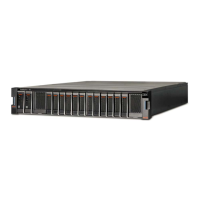FlashSystem 900 Product Guide 12
IBM Variable Stripe RAID
Variable Stripe RAID data protection is a unique, self-healing data protection that is managed
independently by each flash controller on each IBM MicroLatency module. With Variable Stripe RAID,
every flash controller creates a striped data layout across its set of chips similar to a n+1 RAID 5 array
with rotating parity. When the Variable Stripe RAID algorithm detects a failure affecting one or more flash
chips in a RAID stripe, the following process happens:
Data that is stored in the affected regions is reconstructed from the remaining data/parity elements in
1.
the stripe.
All pages in the affected stripe, including the reconstructed data, are moved to reserved space
2.
(overprovisioned area).
Subsequent requests for data in the affected stripe are directed to the new locations (now part of the
3.
normal storage area in the system).
The original location of the affected stripe is added to the available overprovisioned area as a (n-1) +
4.
parity stripe. (For example, if the affected stripe was a 9+1 stripe, it becomes an 8+1 stripe.).
No system-level rebuild process is necessary to maintain data protection or usable capacity after a failure
caught by Variable Stripe RAID. The entire Variable Stripe RAID recovery process is automatic and
transparent to the user and administrator, and typically takes place in less than a second. Variable Stripe
RAID activities are not normally tracked in system logs, but the root causes of failures that are typically
handled by Variable Stripe RAID-plane failures and block failures are tracked in system counters and
reflected in the overall IBM MicroLatency module and system health metrics.
IBM Two-dimensional (2D) Flash RAID
The combination of IBM Variable Stripe RAID and system-level RAID 5 protection across IBM
MicroLatency modules is called two-dimensional (2D) Flash RAID.
RAID 5
With RAID 5 mode, up to 2048 logical volumes (sometimes referred to as LUNs) can be created in the
system, with a minimum size of 1 MB and a maximum size of the full available system capacity. Under the
direction of the management module, RAID module Field Programmable Gate Arrays (FPGAs) can
coordinate data transfer between modules, for example, to rebuild the system-level RAID 5 data layout.
Note: FlashSystem 900 does not support a RAID 0 configuration

